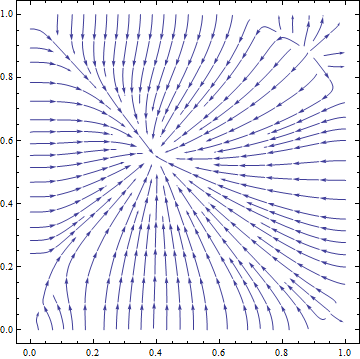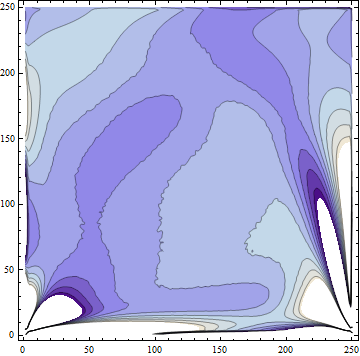I was trying to perform computational fluid dynamics (CFD) post-processing in Mathematica after solving primitive variables from Navier-Stokes equation, mainly $(u,v)$, $(Px,Py)$. Since I am not an expert with the finite difference and NDSolve functionality of Mathematica, I used FORTRAN to perform numerical simulation.
The objective is to generate streamlines and vorticity from $u$ and $v$ values in Mathematica.
I looked online and found this link : http://bugman123.com/FluidMotion/index.html where vorticity and streamlines calculations were demonstrated.
I tried cloning the same code using
u = Import["F:\\Lid_Driven_Cavit\\Run_Max_Interations\\u_final.dat", "CSV"];
v = Import["F:\\Lid_Driven_Cavit\\Run_Max_Interations\\v_final.dat","CSV"];
(* u and v represents velocity components in x and y directions
respectively *)
n = Dimensions[u, 1];
dx = 1/(n - 1);
dy = dx;
\[Psi]= \[Integral]u dx= \[Integral]v dy
\[Omega]= \[PartialD]v/dx-\[PartialD]u/dy
psi = Table[0, {n - 1}, {n - 1}]; Do[
psi[[i, j]] =psi[[i, j - 1]] + dx (u[[i + 1, j - 1]] + u[[i + 1, j]])/2,{j, 2, n - 1}, {i, 1, n - 1}];
psi = ListInterpolation[psi, {{0, 1}, {0, 1}}];
ContourPlot[psi[x, y], {x, 0, 1}, {y, 0, 1}, PlotPoints -> 50,
PlotRange -> All, ContourShading -> False,
Contours -> {-0.08, -0.077,-0.07, -0.06, -0.045, -0.025, -0.01,-0.0025, 0,-8*^-6, 2*^-6, 3*^-5, 8*^-5, 1*^-4, 3*^-4, 6*^-4, 9*^-4},
ContourStyle -> Table[{Hue[2 (1 - x)/3]}, {x, 0, 1, 1/16}]]
But this is not working. I am not sure of the error but I am trying to generate the same code as mentioned in the website.
Also for the omega
omega = ListInterpolation[Table[(v[[i, j]] - v[[i - 1, j]])/dx - (u[[i, j]]- u[[i, j - 1]])/ dx,
{i, 2, n - 1}, {j, 2, n - 1}], {{0, 1}, {0, 1}}];
ContourPlot[omega[x, y], {x, 0, 1}, {y, 0, 1}, PlotPoints -> 50,
PlotRange -> All, ContourShading -> False, Contours -> Range[-14, 7],
ContourStyle -> Table[{Hue[2 (1 - x)/3]}, {x, 0, 1, 1/21}]]
But this is not working as well.
Here is the initial data:






